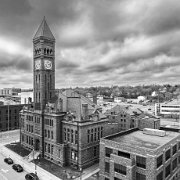
1 Construction began on the first Minnehaha County Courthouse in 1889. The building is a product of local architect Wallace L. Dow, who designed many local buildings including the South Dakota State Penitentiary, the All Saints School, and the Thomas B. McMartin home (now the Pettigrew Home and Museum). The building is constructed of native Sioux Quartzite stone, a popular local building material of the late 19th century. When completed in 1893, Dow claimed the structure would be the “largest courthouse between Chicago and Denver.”
ocm
Old Courthouse Museum
200 W. 6th St. Sioux Falls, SD
Interior courthouse features include slate stairs, granite pillars, stained glass windows, and tiled fireplaces. Perhaps one of the most striking features of the building is the 16 large murals on the walls of the hallways painted between 1915 and 1917. Painted by Norwegian immigrant Ole Running, the murals detail early life in Dakota, natural features, and images of his home in Norway. Running was paid $500 for his work on the walls of the building.
The courthouse was used for county business until 1962, when it became too small for court and administrative activities. A new courthouse was built to the west of the original and the Old Courthouse was slated for demolition to make room for a parking lot. Concerned citizens campaigned to save the Old Courthouse and in 1974 they were successful. The building was converted to a museum and joined with the Pettigrew Home and Museum to become the Siouxland Heritage Museums
ocm
Old Courthouse Museum
200 W. 6th St. Sioux Falls, SD
Interior courthouse features include slate stairs, granite pillars, stained glass windows, and tiled fireplaces. Perhaps one of the most striking features of the building is the 16 large murals on the walls of the hallways painted between 1915 and 1917. Painted by Norwegian immigrant Ole Running, the murals detail early life in Dakota, natural features, and images of his home in Norway. Running was paid $500 for his work on the walls of the building.
The courthouse was used for county business until 1962, when it became too small for court and administrative activities. A new courthouse was built to the west of the original and the Old Courthouse was slated for demolition to make room for a parking lot. Concerned citizens campaigned to save the Old Courthouse and in 1974 they were successful. The building was converted to a museum and joined with the Pettigrew Home and Museum to become the Siouxland Heritage Museums
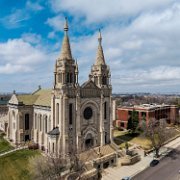
2 The Cathedral of St. Joseph traces its history to the establishment of St. Michael's Church, Sioux Falls' first Catholic parish. It was founded in 1881 and a wooden building was constructed for a church. Two years later a larger brick church was built. It became the Pro-Cathedral when Bishop Martin Marty, who was Vicar Apostolic of the Dakota Territory, arrived in Sioux Falls in 1889. On November 12, of the same year Pope Leo XIII established the Diocese of Sioux Falls, and St. Michael's become the cathedral for the new diocese.
Bishop Thomas O'Gorman succeeded Bishop Marty in 1896 and in time desired a new and larger cathedral. He was a friend of Archbishop John Ireland of St. Paul and he attended the dedication of the Cathedral of St. Paul in 1915. He conferred with the architect of the new St. Paul cathedral Emmanuel Masqueray, who was hired to design the present cathedral in Sioux Falls. St. Michael's was moved and the rectory was torn down. Construction of the new cathedral was begun in 1915. Masqueray died in 1917 and shortages during World War I slowed construction. Edwin Lundie, Masqueray's chief assistant, took over the project. The first Mass in the unfinished cathedral took place on December 8, 1918, and it was dedicated after its completion on May 7, 1919.
The structure has been altered over the years. A Kilgen pipe organ was installed in 1935. A fire in the lower church did significant damage to the cathedral in 1942. Conrad Schmitt Studios decorated the interior the following year, and the marble high altar and tester were installed in 1946. The frosted glass windows were replaced by French stenciled stained glass windows in 1947. A major interior restoration took place between 1970 and 1974. A new free-standing altar was installed at that time. In 2004 the Sacred Heart Chapel was created in the sacristy and the basement was renovated to become a parish hall. Another major renovation of the cathedral interior was completed in 2011.
Bishop Thomas O'Gorman succeeded Bishop Marty in 1896 and in time desired a new and larger cathedral. He was a friend of Archbishop John Ireland of St. Paul and he attended the dedication of the Cathedral of St. Paul in 1915. He conferred with the architect of the new St. Paul cathedral Emmanuel Masqueray, who was hired to design the present cathedral in Sioux Falls. St. Michael's was moved and the rectory was torn down. Construction of the new cathedral was begun in 1915. Masqueray died in 1917 and shortages during World War I slowed construction. Edwin Lundie, Masqueray's chief assistant, took over the project. The first Mass in the unfinished cathedral took place on December 8, 1918, and it was dedicated after its completion on May 7, 1919.
The structure has been altered over the years. A Kilgen pipe organ was installed in 1935. A fire in the lower church did significant damage to the cathedral in 1942. Conrad Schmitt Studios decorated the interior the following year, and the marble high altar and tester were installed in 1946. The frosted glass windows were replaced by French stenciled stained glass windows in 1947. A major interior restoration took place between 1970 and 1974. A new free-standing altar was installed at that time. In 2004 the Sacred Heart Chapel was created in the sacristy and the basement was renovated to become a parish hall. Another major renovation of the cathedral interior was completed in 2011.
![2024-04-08_310839_WTA_Mavic 3 Porter Sculpture Park is located just off Interstate 90 in Montrose, South Dakota (about 25 miles west of Sioux Falls, on the eastern edge of McCook County).[1]...](thumbs/2024-04-08_310839_WTA_Mavic%203.jpg)
3 Porter Sculpture Park is located just off Interstate 90 in Montrose, South Dakota (about 25 miles west of Sioux Falls, on the eastern edge of McCook County).[1] It is on the South Dakota Drift Prairie, only 1/4 of a mile off of the interstate. There are over 60 sculptures in the Park which is situated on 10 acres of tall grass prairie..[2] Many of the sculptures, in the style of industrial art, were made with scrap metal, old farm equipment, or railroad tie plates. The largest sculpture in the park is a 60-foot-tall (18 m) bull head. This sculpture took three years to build, weighs 25 tons, and is equal in size to the heads of Mount Rushmore.[3] Every sculpture in the park was made by Sculptor Wayne Porter. The Park is open May 15 - October 15 annually. Admission is $10 per adult, $5 ages 13–17, and free for ages 12 and under. History of the Artist and Porter Sculpture Park Artist: Wayne Porter is a sculptor who grew up in rural South Dakota and learned to weld as a child in his father's blacksmith shop. He has never taken an art class. He made his first small sculpture at the age of 10. After graduating from South Dakota State University in Brookings with degrees in political science and history, he was a sheep rancher for a few years and worked on sculptures when he had free time. Art: Many of his sculptures are large and most of the early pieces are made from junk/found metal, including the bumper of an old family car, an antique water heater from the local dump, and pieces of old farm machinery. He has written and displays poetry that accompany many of the sculptures. The sculptures are majestic, whimsical, thought provoking, and readily display the influences of the South Dakota prairies he grew up on. They reflect his quick wit, humor, and diverse influences. Sculpture Park: Wayne Porter opened the park in the fall of 2000. He had been ranching and creating sculptures for several years and the art piled up outside of his Dad's blacksmith shop. Over time, cars and buses would come off the highway that runs through the small town of St. Lawrence, SD (pop. 200)to see his sculptures and want to pay him. He realized that sheep ranching is really hard work and he could make a living doing what he loved. He looked for land near Interstate 90 to have better access for tourists and was able to move his sculptures to the current location and open Porter Sculpture Park. The artist continues to make new art in the blacksmith shop where he learned to weld during the offseason and moves the sculptures to the park when they are finished. Prairie: Wayne has been working to restore the prairie to a native South Dakota tall grass prairie. His farmer friend's cows are in the park in the spring before the park opens to give birth to their calves and eat the grass. Healthy prairies require this or an annual burn. It took a few years to see native flowers and grasses returning, and the restoration continues to be a work in progress.
![2024-04-08_310852_WTA_Mavic 3 Porter Sculpture Park is located just off Interstate 90 in Montrose, South Dakota (about 25 miles west of Sioux Falls, on the eastern edge of McCook County).[1]...](thumbs/2024-04-08_310852_WTA_Mavic%203.jpg)
4 Porter Sculpture Park is located just off Interstate 90 in Montrose, South Dakota (about 25 miles west of Sioux Falls, on the eastern edge of McCook County).[1] It is on the South Dakota Drift Prairie, only 1/4 of a mile off of the interstate. There are over 60 sculptures in the Park which is situated on 10 acres of tall grass prairie..[2] Many of the sculptures, in the style of industrial art, were made with scrap metal, old farm equipment, or railroad tie plates. The largest sculpture in the park is a 60-foot-tall (18 m) bull head. This sculpture took three years to build, weighs 25 tons, and is equal in size to the heads of Mount Rushmore.[3] Every sculpture in the park was made by Sculptor Wayne Porter. The Park is open May 15 - October 15 annually. Admission is $10 per adult, $5 ages 13–17, and free for ages 12 and under. History of the Artist and Porter Sculpture Park Artist: Wayne Porter is a sculptor who grew up in rural South Dakota and learned to weld as a child in his father's blacksmith shop. He has never taken an art class. He made his first small sculpture at the age of 10. After graduating from South Dakota State University in Brookings with degrees in political science and history, he was a sheep rancher for a few years and worked on sculptures when he had free time. Art: Many of his sculptures are large and most of the early pieces are made from junk/found metal, including the bumper of an old family car, an antique water heater from the local dump, and pieces of old farm machinery. He has written and displays poetry that accompany many of the sculptures. The sculptures are majestic, whimsical, thought provoking, and readily display the influences of the South Dakota prairies he grew up on. They reflect his quick wit, humor, and diverse influences. Sculpture Park: Wayne Porter opened the park in the fall of 2000. He had been ranching and creating sculptures for several years and the art piled up outside of his Dad's blacksmith shop. Over time, cars and buses would come off the highway that runs through the small town of St. Lawrence, SD (pop. 200)to see his sculptures and want to pay him. He realized that sheep ranching is really hard work and he could make a living doing what he loved. He looked for land near Interstate 90 to have better access for tourists and was able to move his sculptures to the current location and open Porter Sculpture Park. The artist continues to make new art in the blacksmith shop where he learned to weld during the offseason and moves the sculptures to the park when they are finished. Prairie: Wayne has been working to restore the prairie to a native South Dakota tall grass prairie. His farmer friend's cows are in the park in the spring before the park opens to give birth to their calves and eat the grass. Healthy prairies require this or an annual burn. It took a few years to see native flowers and grasses returning, and the restoration continues to be a work in progress.
![2024-04-08_310876_WTA_Mavic 3 Porter Sculpture Park is located just off Interstate 90 in Montrose, South Dakota (about 25 miles west of Sioux Falls, on the eastern edge of McCook County).[1]...](thumbs/2024-04-08_310876_WTA_Mavic%203.jpg)
5 Porter Sculpture Park is located just off Interstate 90 in Montrose, South Dakota (about 25 miles west of Sioux Falls, on the eastern edge of McCook County).[1] It is on the South Dakota Drift Prairie, only 1/4 of a mile off of the interstate. There are over 60 sculptures in the Park which is situated on 10 acres of tall grass prairie..[2] Many of the sculptures, in the style of industrial art, were made with scrap metal, old farm equipment, or railroad tie plates. The largest sculpture in the park is a 60-foot-tall (18 m) bull head. This sculpture took three years to build, weighs 25 tons, and is equal in size to the heads of Mount Rushmore.[3] Every sculpture in the park was made by Sculptor Wayne Porter. The Park is open May 15 - October 15 annually. Admission is $10 per adult, $5 ages 13–17, and free for ages 12 and under. History of the Artist and Porter Sculpture Park Artist: Wayne Porter is a sculptor who grew up in rural South Dakota and learned to weld as a child in his father's blacksmith shop. He has never taken an art class. He made his first small sculpture at the age of 10. After graduating from South Dakota State University in Brookings with degrees in political science and history, he was a sheep rancher for a few years and worked on sculptures when he had free time. Art: Many of his sculptures are large and most of the early pieces are made from junk/found metal, including the bumper of an old family car, an antique water heater from the local dump, and pieces of old farm machinery. He has written and displays poetry that accompany many of the sculptures. The sculptures are majestic, whimsical, thought provoking, and readily display the influences of the South Dakota prairies he grew up on. They reflect his quick wit, humor, and diverse influences. Sculpture Park: Wayne Porter opened the park in the fall of 2000. He had been ranching and creating sculptures for several years and the art piled up outside of his Dad's blacksmith shop. Over time, cars and buses would come off the highway that runs through the small town of St. Lawrence, SD (pop. 200)to see his sculptures and want to pay him. He realized that sheep ranching is really hard work and he could make a living doing what he loved. He looked for land near Interstate 90 to have better access for tourists and was able to move his sculptures to the current location and open Porter Sculpture Park. The artist continues to make new art in the blacksmith shop where he learned to weld during the offseason and moves the sculptures to the park when they are finished. Prairie: Wayne has been working to restore the prairie to a native South Dakota tall grass prairie. His farmer friend's cows are in the park in the spring before the park opens to give birth to their calves and eat the grass. Healthy prairies require this or an annual burn. It took a few years to see native flowers and grasses returning, and the restoration continues to be a work in progress.
![2024-04-08_310880_WTA_Mavic 3 Porter Sculpture Park is located just off Interstate 90 in Montrose, South Dakota (about 25 miles west of Sioux Falls, on the eastern edge of McCook County).[1]...](thumbs/2024-04-08_310880_WTA_Mavic%203.jpg)
6 Porter Sculpture Park is located just off Interstate 90 in Montrose, South Dakota (about 25 miles west of Sioux Falls, on the eastern edge of McCook County).[1] It is on the South Dakota Drift Prairie, only 1/4 of a mile off of the interstate. There are over 60 sculptures in the Park which is situated on 10 acres of tall grass prairie..[2] Many of the sculptures, in the style of industrial art, were made with scrap metal, old farm equipment, or railroad tie plates. The largest sculpture in the park is a 60-foot-tall (18 m) bull head. This sculpture took three years to build, weighs 25 tons, and is equal in size to the heads of Mount Rushmore.[3] Every sculpture in the park was made by Sculptor Wayne Porter. The Park is open May 15 - October 15 annually. Admission is $10 per adult, $5 ages 13–17, and free for ages 12 and under. History of the Artist and Porter Sculpture Park Artist: Wayne Porter is a sculptor who grew up in rural South Dakota and learned to weld as a child in his father's blacksmith shop. He has never taken an art class. He made his first small sculpture at the age of 10. After graduating from South Dakota State University in Brookings with degrees in political science and history, he was a sheep rancher for a few years and worked on sculptures when he had free time. Art: Many of his sculptures are large and most of the early pieces are made from junk/found metal, including the bumper of an old family car, an antique water heater from the local dump, and pieces of old farm machinery. He has written and displays poetry that accompany many of the sculptures. The sculptures are majestic, whimsical, thought provoking, and readily display the influences of the South Dakota prairies he grew up on. They reflect his quick wit, humor, and diverse influences. Sculpture Park: Wayne Porter opened the park in the fall of 2000. He had been ranching and creating sculptures for several years and the art piled up outside of his Dad's blacksmith shop. Over time, cars and buses would come off the highway that runs through the small town of St. Lawrence, SD (pop. 200)to see his sculptures and want to pay him. He realized that sheep ranching is really hard work and he could make a living doing what he loved. He looked for land near Interstate 90 to have better access for tourists and was able to move his sculptures to the current location and open Porter Sculpture Park. The artist continues to make new art in the blacksmith shop where he learned to weld during the offseason and moves the sculptures to the park when they are finished. Prairie: Wayne has been working to restore the prairie to a native South Dakota tall grass prairie. His farmer friend's cows are in the park in the spring before the park opens to give birth to their calves and eat the grass. Healthy prairies require this or an annual burn. It took a few years to see native flowers and grasses returning, and the restoration continues to be a work in progress.
![2024-04-08_310885_WTA_Mavic 3 Porter Sculpture Park is located just off Interstate 90 in Montrose, South Dakota (about 25 miles west of Sioux Falls, on the eastern edge of McCook County).[1]...](thumbs/2024-04-08_310885_WTA_Mavic%203.jpg)
7 Porter Sculpture Park is located just off Interstate 90 in Montrose, South Dakota (about 25 miles west of Sioux Falls, on the eastern edge of McCook County).[1] It is on the South Dakota Drift Prairie, only 1/4 of a mile off of the interstate. There are over 60 sculptures in the Park which is situated on 10 acres of tall grass prairie..[2] Many of the sculptures, in the style of industrial art, were made with scrap metal, old farm equipment, or railroad tie plates. The largest sculpture in the park is a 60-foot-tall (18 m) bull head. This sculpture took three years to build, weighs 25 tons, and is equal in size to the heads of Mount Rushmore.[3] Every sculpture in the park was made by Sculptor Wayne Porter. The Park is open May 15 - October 15 annually. Admission is $10 per adult, $5 ages 13–17, and free for ages 12 and under. History of the Artist and Porter Sculpture Park Artist: Wayne Porter is a sculptor who grew up in rural South Dakota and learned to weld as a child in his father's blacksmith shop. He has never taken an art class. He made his first small sculpture at the age of 10. After graduating from South Dakota State University in Brookings with degrees in political science and history, he was a sheep rancher for a few years and worked on sculptures when he had free time. Art: Many of his sculptures are large and most of the early pieces are made from junk/found metal, including the bumper of an old family car, an antique water heater from the local dump, and pieces of old farm machinery. He has written and displays poetry that accompany many of the sculptures. The sculptures are majestic, whimsical, thought provoking, and readily display the influences of the South Dakota prairies he grew up on. They reflect his quick wit, humor, and diverse influences. Sculpture Park: Wayne Porter opened the park in the fall of 2000. He had been ranching and creating sculptures for several years and the art piled up outside of his Dad's blacksmith shop. Over time, cars and buses would come off the highway that runs through the small town of St. Lawrence, SD (pop. 200)to see his sculptures and want to pay him. He realized that sheep ranching is really hard work and he could make a living doing what he loved. He looked for land near Interstate 90 to have better access for tourists and was able to move his sculptures to the current location and open Porter Sculpture Park. The artist continues to make new art in the blacksmith shop where he learned to weld during the offseason and moves the sculptures to the park when they are finished. Prairie: Wayne has been working to restore the prairie to a native South Dakota tall grass prairie. His farmer friend's cows are in the park in the spring before the park opens to give birth to their calves and eat the grass. Healthy prairies require this or an annual burn. It took a few years to see native flowers and grasses returning, and the restoration continues to be a work in progress.
![2024-04-08_310891_WTA_Mavic 3 Porter Sculpture Park is located just off Interstate 90 in Montrose, South Dakota (about 25 miles west of Sioux Falls, on the eastern edge of McCook County).[1]...](thumbs/2024-04-08_310891_WTA_Mavic%203.jpg)
8 Porter Sculpture Park is located just off Interstate 90 in Montrose, South Dakota (about 25 miles west of Sioux Falls, on the eastern edge of McCook County).[1] It is on the South Dakota Drift Prairie, only 1/4 of a mile off of the interstate. There are over 60 sculptures in the Park which is situated on 10 acres of tall grass prairie..[2] Many of the sculptures, in the style of industrial art, were made with scrap metal, old farm equipment, or railroad tie plates. The largest sculpture in the park is a 60-foot-tall (18 m) bull head. This sculpture took three years to build, weighs 25 tons, and is equal in size to the heads of Mount Rushmore.[3] Every sculpture in the park was made by Sculptor Wayne Porter. The Park is open May 15 - October 15 annually. Admission is $10 per adult, $5 ages 13–17, and free for ages 12 and under. History of the Artist and Porter Sculpture Park Artist: Wayne Porter is a sculptor who grew up in rural South Dakota and learned to weld as a child in his father's blacksmith shop. He has never taken an art class. He made his first small sculpture at the age of 10. After graduating from South Dakota State University in Brookings with degrees in political science and history, he was a sheep rancher for a few years and worked on sculptures when he had free time. Art: Many of his sculptures are large and most of the early pieces are made from junk/found metal, including the bumper of an old family car, an antique water heater from the local dump, and pieces of old farm machinery. He has written and displays poetry that accompany many of the sculptures. The sculptures are majestic, whimsical, thought provoking, and readily display the influences of the South Dakota prairies he grew up on. They reflect his quick wit, humor, and diverse influences. Sculpture Park: Wayne Porter opened the park in the fall of 2000. He had been ranching and creating sculptures for several years and the art piled up outside of his Dad's blacksmith shop. Over time, cars and buses would come off the highway that runs through the small town of St. Lawrence, SD (pop. 200)to see his sculptures and want to pay him. He realized that sheep ranching is really hard work and he could make a living doing what he loved. He looked for land near Interstate 90 to have better access for tourists and was able to move his sculptures to the current location and open Porter Sculpture Park. The artist continues to make new art in the blacksmith shop where he learned to weld during the offseason and moves the sculptures to the park when they are finished. Prairie: Wayne has been working to restore the prairie to a native South Dakota tall grass prairie. His farmer friend's cows are in the park in the spring before the park opens to give birth to their calves and eat the grass. Healthy prairies require this or an annual burn. It took a few years to see native flowers and grasses returning, and the restoration continues to be a work in progress.
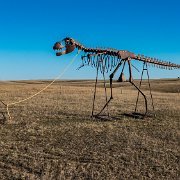
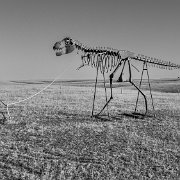
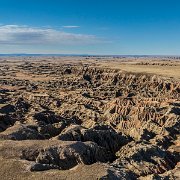
South Dakota